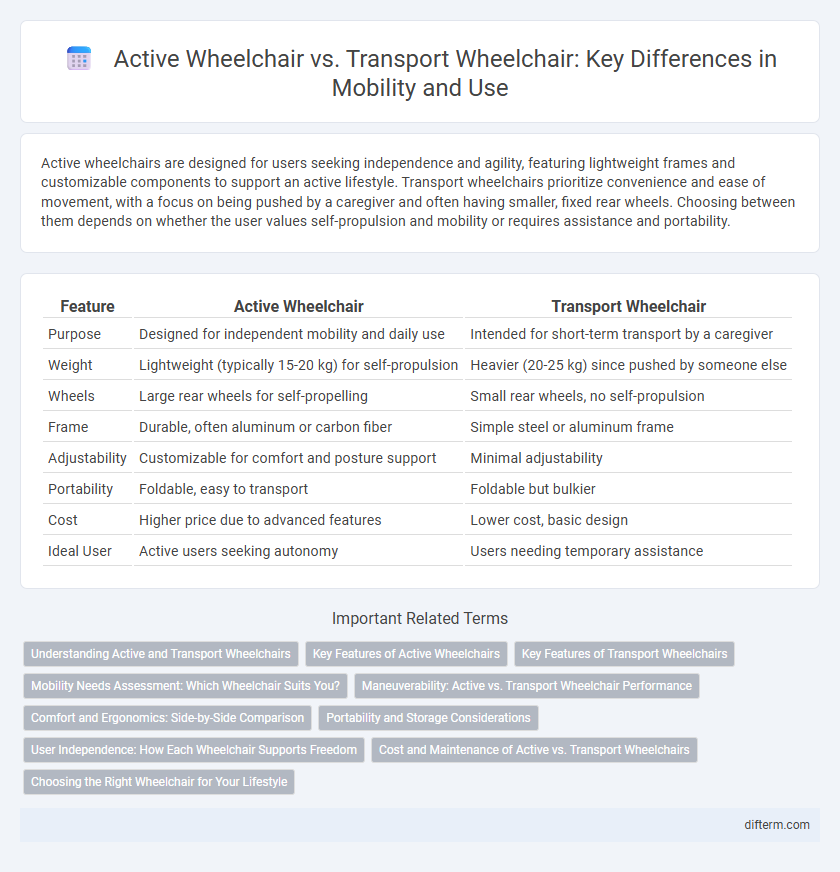Active wheelchairs are designed for users seeking independence and agility, featuring lightweight frames and customizable components to support an active lifestyle. Transport wheelchairs prioritize convenience and ease of movement, with a focus on being pushed by a caregiver and often having smaller, fixed rear wheels. Choosing between them depends on whether the user values self-propulsion and mobility or requires assistance and portability.
Table of Comparison
| Feature | Active Wheelchair | Transport Wheelchair |
|---|---|---|
| Purpose | Designed for independent mobility and daily use | Intended for short-term transport by a caregiver |
| Weight | Lightweight (typically 15-20 kg) for self-propulsion | Heavier (20-25 kg) since pushed by someone else |
| Wheels | Large rear wheels for self-propelling | Small rear wheels, no self-propulsion |
| Frame | Durable, often aluminum or carbon fiber | Simple steel or aluminum frame |
| Adjustability | Customizable for comfort and posture support | Minimal adjustability |
| Portability | Foldable, easy to transport | Foldable but bulkier |
| Cost | Higher price due to advanced features | Lower cost, basic design |
| Ideal User | Active users seeking autonomy | Users needing temporary assistance |
Understanding Active and Transport Wheelchairs
Active wheelchairs are designed with lightweight frames and customizable features to enhance user independence and mobility, ideal for daily activities and prolonged use. Transport wheelchairs are typically lighter and more compact, intended for short-term use and ease of transport by a caregiver. Selecting between active and transport wheelchairs depends on factors such as user activity level, durability requirements, and portability preferences.
Key Features of Active Wheelchairs
Active wheelchairs feature lightweight frames, customizable seating, and enhanced maneuverability, designed to support users with an active lifestyle who require greater independence and mobility. These wheelchairs often incorporate high-performance materials such as aluminum or titanium, offering durability and ease of propulsion. Key features also include adjustable axle positions for optimized propulsion efficiency and ergonomic hand rims to reduce fatigue during extended use.
Key Features of Transport Wheelchairs
Transport wheelchairs feature lightweight aluminum frames designed for easy maneuverability and portability, often folding compactly for storage and travel convenience. Unlike active wheelchairs, transport models have smaller rear wheels and rely on a caregiver for pushing, enhancing safety and control in tight spaces. They typically include features such as swing-away footrests and padded armrests to improve passenger comfort during short-term use.
Mobility Needs Assessment: Which Wheelchair Suits You?
Active wheelchairs prioritize lightweight frames and enhanced maneuverability for users with an active lifestyle, while transport wheelchairs focus on portability and ease of use for caregivers. Mobility needs assessments evaluate factors such as user strength, daily activity levels, and transportation requirements to recommend the ideal wheelchair type. Selecting the right wheelchair ensures optimal independence, comfort, and mobility tailored to individual functional capabilities.
Maneuverability: Active vs. Transport Wheelchair Performance
Active wheelchairs offer superior maneuverability with lightweight frames and customizable features that enable users to navigate tight spaces and uneven terrain efficiently. Transport wheelchairs prioritize portability and ease of use, featuring lighter, foldable designs but with limited control and reduced agility in comparison. The performance of active wheelchairs in handling complex environments significantly outmatches the simpler, less responsive operation of transport wheelchairs.
Comfort and Ergonomics: Side-by-Side Comparison
Active wheelchairs feature customizable seating, adjustable backrests, and enhanced cushioning designed for extended use, promoting optimal posture and reducing pressure sores. Transport wheelchairs prioritize lightweight frames and foldability, often sacrificing advanced ergonomic support, which may lead to discomfort during prolonged use. Users requiring long-term mobility benefit from the superior comfort and ergonomic design of active wheelchairs, while transport models serve better for short-term or occasional mobility needs.
Portability and Storage Considerations
Active wheelchairs feature lightweight frames and foldable designs, enhancing portability for frequent users who prioritize independence and easy transport. Transport wheelchairs are typically lighter and more compact, allowing caregivers to lift and store them conveniently in tight spaces such as car trunks or closets. Both wheelchair types offer varying levels of storage efficiency, with active models balancing durability and portability, while transport wheelchairs emphasize minimal weight and foldability for optimal storage solutions.
User Independence: How Each Wheelchair Supports Freedom
Active wheelchairs prioritize user independence by offering enhanced maneuverability, lightweight frames, and customizable features tailored to an individual's specific needs, empowering users to navigate diverse environments with confidence. Transport wheelchairs support freedom through their compact, foldable design and reduced weight, making them ideal for caregivers to assist users during travel and outings. Both types optimize mobility but cater to different levels of autonomy and lifestyle requirements.
Cost and Maintenance of Active vs. Transport Wheelchairs
Active wheelchairs generally have a higher upfront cost due to durable materials and customizable features designed for long-term use and independence, while transport wheelchairs are more affordable and lightweight but may require more frequent repairs due to less robust construction. Maintenance expenses for active wheelchairs tend to be lower over time because of their sturdy components and easier access to replacement parts. Transport wheelchairs often incur higher maintenance costs from wear on wheels and brakes, especially with frequent use in various environments.
Choosing the Right Wheelchair for Your Lifestyle
Active wheelchairs are designed for individuals who require greater mobility and independence, featuring lightweight frames and customizable options that enhance maneuverability and comfort. Transport wheelchairs prioritize portability and ease of use, often being lighter and foldable, making them ideal for short-term use or assistance in travel. Selecting the right wheelchair involves assessing daily activities, physical requirements, and lifestyle needs to ensure optimal support and functionality.
active wheelchair vs transport wheelchair Infographic

 difterm.com
difterm.com